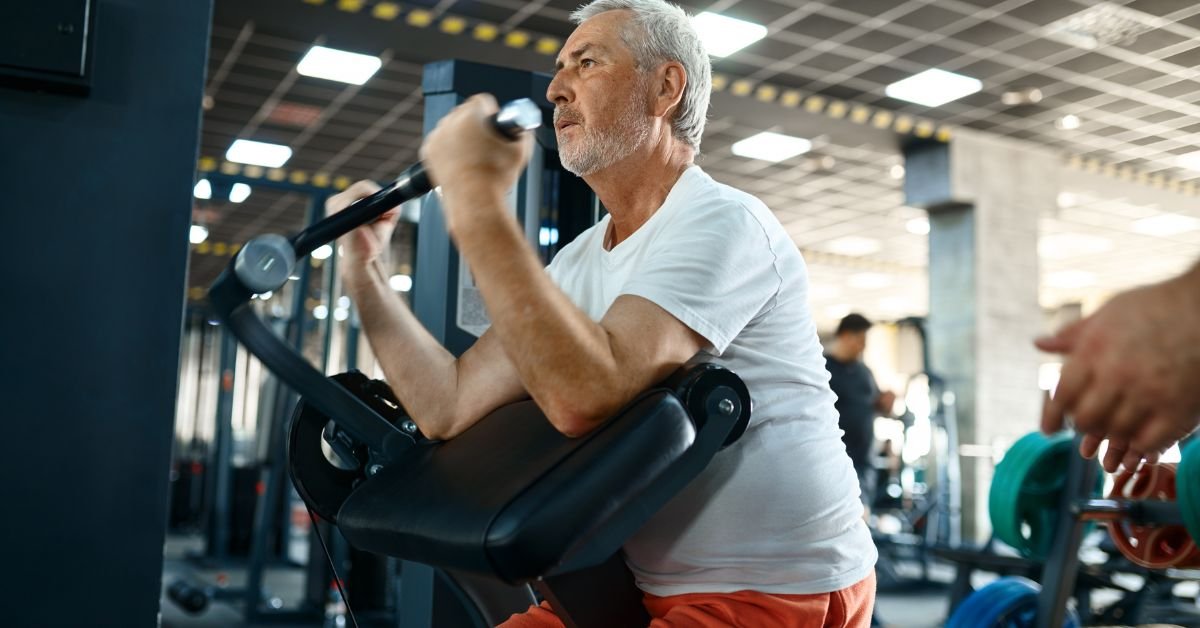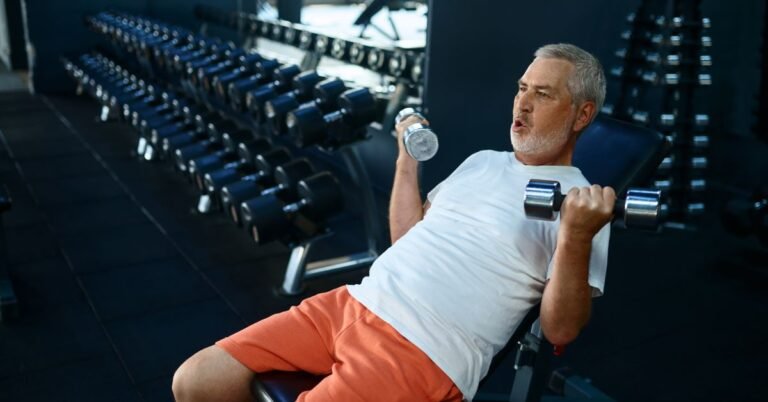The short answer is yes, you can gain muscle at any age. Our muscles are living tissues which respond to the load and stress we put upon them. Strength training, with appropriate loading, nutrition and rest leads to increased muscle mass and strength, no matter what age you are.
However, as our bodies get older we face more challenges when it comes to maintaining and increasing muscle mass. Let’s look at this question in more detail below.
What we’ll cover:
How does age affect muscle growth?
While people of all ages can gain muscle through exercise, a gradual reduction in muscle mass, strength and power occurs as part of the normal ageing process. Unfortunately, this decline starts pretty early – around the age of 30 for some. From around the age of 50, there’s a sudden increase in this loss, with some studies reporting 1-2% lean muscle mass loss per year, and a 3% muscle strength loss per year after the age of 60.1
This loss of muscle mass and strength can have devastating consequences as we age; it is associated with reduced independence, reduced ability to carry out functional activities and daily tasks, reduced quality of life, and even early death.2 And our muscles aren’t only important for us to be able to perform physically. Lower muscle mass is also associated with several chronic diseases, including cardiovascular disease, diabetes and cancer.3
The good news though is that you can take control of this.
Counteracting muscle loss as we age
There’s evidence to show that a large contributor to the loss of muscle mass and strength in ageing is inactivity.4 There’s also evidence which proves that these changes can be reversed. Numerous systemic reviews (big reviews of multiple smaller studies) support the use of strength training for improving the muscle mass, strength and physical functioning of older adults.5678
One study included 1,600 participants between the ages of 21 and 80 years old, who all completed strength training 2-3 days per week over a 10 week period.9 The results showed an average gain of 1.4kg in lean muscle mass and there was no significant difference in muscle mass gain between the age groups.
Another study showed no difference between the muscle mass gains over a longer period of 6 months, between men and women aged 20-30 years old, and older adults between 65-75 years old.10
One of our favourite studies though was one which was carried out on a group of 90 year olds.11 The participants were split into two groups: either an exercise intervention for 12 weeks, or a control group.
The intervention consisted of twice weekly sessions of exercise, including upper and lower body resistance exercises (with progressively increasing loads, 8-10 repetitions at 40-60% 1RM) using resistance machines, balance exercises and gait training. Each training lasted about 40 minutes. The control group performed 30 minutes of mobility exercises, 4 days a week.
The results were pretty remarkable. The exercise intervention group showed significant improvements in muscle strength and power measures, muscle mass in multiple lower limb muscles and functional performance measures.
So it is possible to gain muscle mass and strength even at 90!
There are numerous physical and mental health benefits to doing strength training exercises, and it’s arguably even more important as we get older. So we think it’s something everyone should consider starting if they are able to, no matter what age or fitness level you are at.
The importance of protein in gaining muscle
As well as exercising the muscles through resistance training, adequate protein consumption is another important consideration when looking at gaining muscle. This is more important as we get older, since older adults require more protein in order to stimulate the same level of protein synthesis as younger people.
One study compared two groups of men over the age of 70; one group consuming the recommended daily dose of protein and one group consuming double that dose (1.6g/kg/body weight/ day) over a 10 week period. The group who consumed the higher dose showed increases in lean mass and leg power, whereas decreases were seen in the other group.12
This and other studies we’ve highlighted above show that muscle mass and strength gains are possible no matter what age we are. So long as we are providing the muscles with the right stimulus (regular strength training) and nutrition (enough protein).
If you’d like to learn more and for help getting started, check out our complete Beginners Guide to Strength Training for Older Adults. Or, why not have a go at following our Free 6 Week Beginners Programme from home?
References
- von Haehling, S., Morley, J. E., & Anker, S. D. (2010). An overview of sarcopenia: facts and numbers on prevalence and clinical impact. Journal of cachexia, sarcopenia and muscle, 1(2), 129–133. https://doi.org/10.1007/s13539-010-0014-2
- Jones, T. E., Stephenson, K. W., King, J. G., Knight, K. R., Marshall, T. L., & Scott, W. B. (2009). Sarcopenia–mechanisms and treatments. Journal of geriatric physical therapy (2001), 32(2), 83–89.
- Mcleod, J. C., Stokes, T., & Phillips, S. M. (2019). Resistance Exercise Training as a Primary Countermeasure to Age-Related Chronic Disease. Frontiers in physiology, 10, 645. https://doi.org/10.3389/fphys.2019.00645
- Bell, K. E., von Allmen, M. T., Devries, M. C., & Phillips, S. M. (2016). Muscle Disuse as a Pivotal Problem in Sarcopenia-related Muscle Loss and Dysfunction. The Journal of frailty & aging, 5(1), 33–41. https://doi.org/10.14283/jfa.2016.78
- Liu, C. J., & Latham, N. K. (2009). Progressive resistance strength training for improving physical function in older adults. The Cochrane database of systematic reviews, 2009(3), CD002759. https://doi.org/10.1002/14651858.CD002759.pub2
- Liu, Cj., Shiroy, D.M., Jones, L.Y. et al. Systematic review of functional training on muscle strength, physical functioning, and activities of daily living in older adults. Eur Rev Aging Phys Act 11, 95–106 (2014). https://doi.org/10.1007/s11556-014-0144-1
- Latham, N. K., Bennett, D. A., Stretton, C. M., & Anderson, C. S. (2004). Systematic review of progressive resistance strength training in older adults. The journals of gerontology. Series A, Biological sciences and medical sciences, 59(1), 48–61. https://doi.org/10.1093/gerona/59.1.m48
- Khodadad Kashi S, Mirzazadeh ZS, Saatchian V. A Systematic Review and Meta-Analysis of Resistance Training on Quality of Life, Depression, Muscle Strength, and Functional Exercise Capacity in Older Adults Aged 60 Years or More. Biological Research For Nursing. 2023;25(1):88-106. doi:10.1177/10998004221120945
- Westcott WL, Winett RA, Annesi JJ, et al. Prescribing physical activity: applying the ACSM protocols for exercise type, intensity, and duration across 3 training frequencies. The Physician and Sportsmedicine. 2009 Jun;37(2):51-58. DOI: 10.3810/psm.2009.06.1709. PMID: 20048509.
- Roth, S. M., Ivey, F. M., Martel, G. F., Lemmer, J. T., Hurlbut, D. E., Siegel, E. L., Metter, E. J., Fleg, J. L., Fozard, J. L., Kostek, M. C., Wernick, D. M., & Hurley, B. F. (2001). Muscle size responses to strength training in young and older men and women. Journal of the American Geriatrics Society, 49(11), 1428–1433. https://doi.org/10.1046/j.1532-5415.2001.4911233.x
- Cadore, E. L., Casas-Herrero, A., Zambom-Ferraresi, F., Idoate, F., Millor, N., Gómez, M., Rodriguez-Mañas, L., & Izquierdo, M. (2014). Multicomponent exercises including muscle power training enhance muscle mass, power output, and functional outcomes in institutionalized frail nonagenarians. Age (Dordrecht, Netherlands), 36(2), 773–785. https://doi.org/10.1007/s11357-013-9586-z
- Mitchell, C. J., Milan, A. M., Mitchell, S. M., Zeng, N., Ramzan, F., Sharma, P., Knowles, S. O., Roy, N. C., Sjödin, A., Wagner, K. H., & Cameron-Smith, D. (2017). The effects of dietary protein intake on appendicular lean mass and muscle function in elderly men: a 10-wk randomized controlled trial. The American journal of clinical nutrition, 106(6), 1375–1383. https://doi.org/10.3945/ajcn.117.160325




